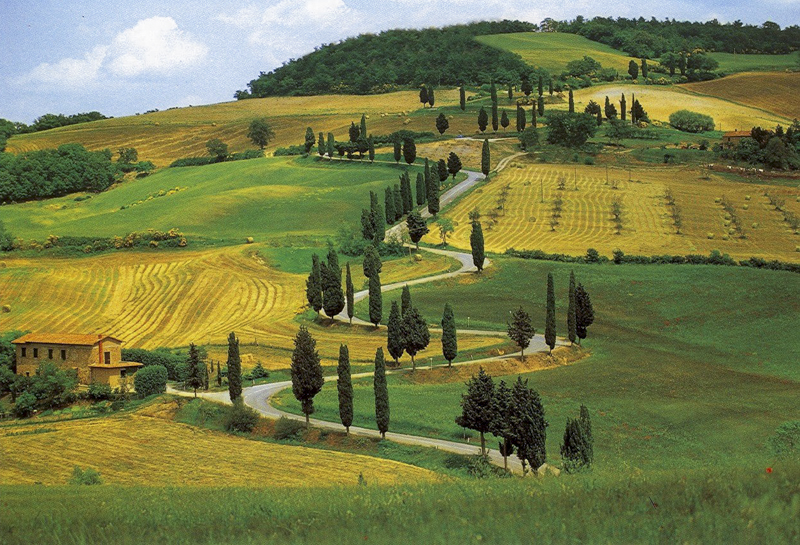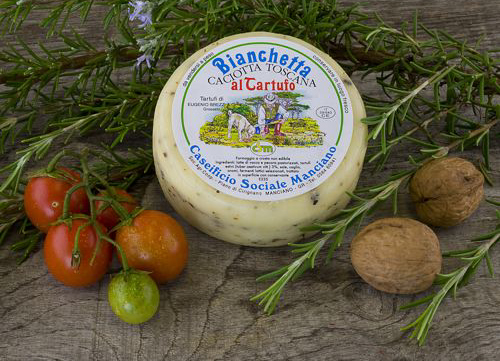Caciotta Info
A True Italian Farmstead Cheese
While Traveling in Italy, this is one of the most common forms of cheese that I can find on the Italian table. It is one to be eaten fresh as a table cheese or as an ingredient in their favorite dishes.
Caciotta is a classic cheeses traditionally made on the Italian farm by the family members, but today it may be found being made on a larger scale by cheese cooperatives as well.
The name is derived from the old Latin word for cheese, 'Caseus', from which our modern words of Cheese, Kase, and Queso are derived.
It's most noted presence is in the Pienza/Siena region of south central Tuscany but it can be found in various forms throughout Italy.
What is Caciotta
As was the Italian farm tradition, a farm would often be a combination of both ewes, goats and, as time progressed, a mix of cows was also added. Later, even buffalo was used to make this cheese in southern Italy.
For convenience sake, many of the farms would have had this mix of all milk going into the same vat and making this one specific farm cheese. Hence, the makeup of this cheese today may be a range of 100% cows milk, ewes milk, or any combo of the three milks often labeled 'tre latte'. Even all Buffalo milk versions were made.
Caciotta is considered to be one of the traditional farmhouse cheeses that are rural and artisan in nature, and many varieties have been made in the Italian regions of Umbria and Tuscany for many years.
The general term Caciotta includes a wide variety of soft cheeses produced in various Italian regions, especially of central Italy. The term usually refers to small-medium-sized cheeses (1.5-2.5 lbs.) of cylindrical shape with low height (2-4 inches) and diameter of 4-8 inches, made with cows milk (tipo dolce), ewes milk (tipo saporito/lazial) or both, and ripened from one to several weeks.
It was always best made in the spring when the wildflowers were blooming.
This would be called "Cacio Marzolino", or "March cheese", and id known for its sweet and fragrant character.
Caciotta cheeses have a semi-soft texture with a creamy firm consistency, providing a flavor that ranges from mild to tangy as it ages. The rind is yellowish, while the paste is soft, compact and a pale yellow color.
The taste is sweet and resembles the taste of the milk. It keeps a long time in a cool and ventilated place, but once cut, it should be kept in the refrigerator, wrapped in a brine dampened cloth or a sheet of foil, and consumed within a short time to prevent it from drying out.
Caciotta has many uses, for example, cut into cubes and added in green salads, but also in the preparation of cooked foods: hot filling for crepes while these are still in the pan or on the plate, or mixed with the eggs to prepare the omelettes.
In addition, although not foreseen in the traditional recipe, it can turn into a sauce with the addition of egg yolks, add this sauce to the local pasta (pici, a type of homemade spaghetti characteristic of the Senese) or your favorite pasta.
It has an intense aroma and a soft consistency, and its delicate flavour goes well with strongly flavored food such as cured ham, but also with sweet fig or cherry jam, honey, and above all with Tuscan bread. The sweet aroma of the Tuscan cheese is reminiscent of freshly milked milk and is perfect served with other typical Tuscan products like salami and wine.
Variations in Style
One thing that has always intrigued me about this cheese is the various ways in which it is presented. The base process is always quite similar, but it has a variety of additions to the paste and the surface treatment can be varied as well. I have tried most of these and they are all good.
- Cracked black peppercorns spaced throughout the cheese body
- Mild to fiery additions of red peppers mixed into the cheese
- Additions of small bits of black summer truffle (Tartufa)
- A light rub of good olive oil for its aromatic addition
- The rind can be washed several times with crushed tomatoes, a tradition that goes back to not wanting to waste the valuable olive oil on coating the cheese
- The cheese is sometimes aged in layers of grey ash inside large clay vessels for weeks or months
- It can be aged under hay, 'Caciotta Sotto il Fieno'. A rare cheese, it is aged this way to retain the fresh milk flavor and also add hints of the countryside from which it comes.
- It can be wrapped in leaves and aged
- Soaked in wine or the marc from wine making.
- It can even be allowed to develop a natural rind of geotrichum with longer aging.
A Very Unique Process Step
For this cheese, a very short stir is required and the curd is transferred soon before much acid has been developed or whey released.
Because of this, it is very important to extend the warm period, well after the cheese has been formed, to allow the final culture activity to complete its job because the Thermophilic bacteria like a much warmer temperature.
Since the cheese will begin to cool down shortly after molding, an additional step is needed. Traditionally they were transferred to an artisanal warm room to maintain the warm temperature for 1-2hours. This was called the 'Stufatura' which means steaming in Italian.
On a smaller scale I do this here by supporting a small draining plate in a larger pot or insulated cooler and adding hot water to maintain the temperature.
You should have this sanitized, set up, and ready to go while the milk is heating.
A Great Molded Cheese for Beginners
This is an ideal cheese for folks making their first molded cheese.
It is relatively quick to make and requires simple equipment (no press or weights involved). It also takes only days or weeks to age and not months.
Having this quick turn-around is a big plus in evaluating how you are doing with your cheese making.








































